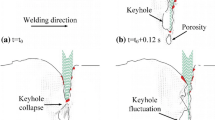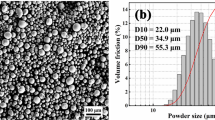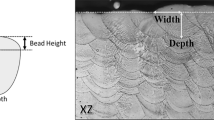Abstract
The dynamic behavior of the backside of a molten pool was observed by high-speed imaging during the full-penetration laser welding (FPLW) of the Inconel 617 superalloy, and the influence of the welding parameters on the dynamic behavior was studied. Furthermore, the relationship between the keyhole penetration status and the formation of defects, such as spatter and porosity, was investigated. The results showed that during FPLW, the backside of the molten pool was unstable and fluctuated periodically due to the dynamic pressure balance acting on the keyhole wall. The liquid metal under the keyhole was pushed out by the metal vapor in the keyhole to form a bulge protruding from the molten pool surface. The size and height of the bulge were not stable. The keyhole periodically penetrated through the bulge and sprayed spatter outward. Sometimes a sharp increase in the metal vapor recoil pressure in the local area under the keyhole would cause the liquid metal droplet to be pushed away from the molten pool. The proportion of the keyhole penetration time should be controlled within a moderate range (process window) to inhibit processing defects formation during the FPLW process. When the proportion exceeded this range, excessive spatter would lead to weld underfill. When the proportion was below this range, the keyhole-induced porosity in the weld would be generated. Increasing the welding speed helped to improve the stability of the keyhole. Compared with thick plate welding, the process window of thin plate welding was wider.

















Similar content being viewed by others
Supplementary information
Supplementary data to this article can be found online at https://doi.org/10.1007/s00170-021-08187-9.
Code availability
Not applicable.
References
Wu D, Hua X, Huang L, Li F, Cai Y (2019) Observation of the keyhole behavior, spatter, and keyhole-induced bubble formation in laser welding of a steel/glass sandwich. Weld World 63(3):815–823. https://doi.org/10.1007/s40194-019-00710-7
Huang Y, Hua X, Li F, Shen C, Mou G, Tang B (2020) Spatter feature analysis in laser welding based on motion tracking method. J Manuf Process 55:220–229. https://doi.org/10.1016/j.jmapro.2020.04.016
Liu P, Huang L, Gan L, Lei Y (2020) Effect of plate thickness on weld pool dynamics and keyhole-induced porosity formation in laser welding of Al alloy. Int J Adv Manuf Technol 111(3–4):735–747. https://doi.org/10.1007/s00170-020-05818-5
Zhao C, Parab ND, Li X, Fezzaa K, Tan W, Rollett AD, Sun T (2020) Critical instability at moving keyhole tip generates porosity in laser melting. Science 370(6520):1080. https://doi.org/10.1126/science.abd1587
He E, Liu J, Lee J, Wang K, Politis DJ, Chen L, Wang L (2017) Effect of porosities on tensile properties of laser-welded Al-Li alloy: an experimental and modelling study. Int J Adv Manuf Technol 95(1–4):659–671. https://doi.org/10.1007/s00170-017-1175-3
Wu SC, Yu C, Zhang WH, Fu YN, Helfen L (2014) Porosity induced fatigue damage of laser welded 7075–T6 joints investigated via synchrotron X-ray microtomography. Sci Technol Weld Join 20(1):11–19. https://doi.org/10.1179/1362171814y.0000000249
Nakamura H, Kawahito Y, Nishimoto K, Katayama S (2015) Elucidation of melt flows and spatter formation mechanisms during high power laser welding of pure titanium. J Laser Appl 27(3). https://doi.org/10.2351/1.4922383
Li X, Li F, Hua X, Wang M (2020) Analysis of back-weld spatters in laser welding of CP-Ti. J Manuf Process 53:48–54. https://doi.org/10.1016/j.jmapro.2020.01.030
Zhang D, Li C, Liu X, Cao Y, Wu D (2018) Numerical study of spatter formation during fiber laser welding of aluminum alloy. J Manuf Process 31:72–79. https://doi.org/10.1016/j.jmapro.2017.11.006
Lu R, Wei H, Li F, Zhang Z, Liang Z, Li B (2020) In-situ monitoring of the penetration status of keyhole laser welding by using a support vector machine with interaction time conditioned keyhole behaviors. Opt Lasers Eng 130. https://doi.org/10.1016/j.optlaseng.2020.106099
Zhang Y, Li F, Liang Z, Ying Y, Lin Q, Wei H (2018) Correlation analysis of penetration based on keyhole and plasma plume in laser welding. J Mater Process Technol 256:1–12. https://doi.org/10.1016/j.jmatprotec.2018.01.032
Zhang M, Zhang Z, Tang K, Mao C, Hu Y, Chen G (2018) Analysis of mechanisms of underfill in full penetration laser welding of thick stainless steel with a 10 kW fiber laser. Opt Laser Technol 98:97–105. https://doi.org/10.1016/j.optlastec.2017.07.037
Zhang Z, Li B, Zhang W, Lu R, Wada S, Zhang Y (2020) Real-time penetration state monitoring using convolutional neural network for laser welding of tailor rolled blanks. J Manuf Syst 54:348–360. https://doi.org/10.1016/j.jmsy.2020.01.006
Kim H, Nam K, Oh S, Ki H (2021) Deep-learning-based real-time monitoring of full-penetration laser keyhole welding by using the synchronized coaxial observation method. J Manuf Process 68:1018–1030. https://doi.org/10.1016/j.jmapro.2021.06.029
Wang Z, Oliveira JP, Zeng Z, Bu X, Peng B, Shao X (2019) Laser beam oscillating welding of 5A06 aluminum alloys: Microstructure, porosity and mechanical properties. Opt Laser Technol 111:58–65. https://doi.org/10.1016/j.optlastec.2018.09.036
Cheng H, Zhou L, Sun J, Wen S, Wang Y, Chang B, Du D (2021) Processing modes in laser beam oscillating welding of Al 6Cu alloy. J Manuf Process 68:1261–1270. https://doi.org/10.1016/j.jmapro.2021.06.049
Huang Y, Shen C, Ji X, Li F, Zhang Y, Hua X (2020) Effects of Mg content on keyhole behaviour during deep penetration laser welding of Al-Mg alloys. Opt Laser Technol 125. https://doi.org/10.1016/j.optlastec.2020.106056
Tsukamoto S (2013) 2 - Developments in CO2 laser welding. In: Katayama S (ed) Handbook of laser welding technologies. Woodhead Publishing, pp 17–46
Matsunawa A, Kim J-D, Seto N, Mizutani M, Katayama S (1998) Dynamics of keyhole and molten pool in laser welding. J Laser Appl 10(6):247–254. https://doi.org/10.2351/1.521858
Huang L, Hua X, Wu D, Fang L, Cai Y, Ye Y (2018) Effect of magnesium content on keyhole-induced porosity formation and distribution in aluminum alloys laser welding. J Manuf Process 33:43–53. https://doi.org/10.1016/j.jmapro.2018.04.023
Xu J, Rong Y, Huang Y, Wang P, Wang C (2018) Keyhole-induced porosity formation during laser welding. J Mater Process Technol 252:720–727. https://doi.org/10.1016/j.jmatprotec.2017.10.038
Kawahito Y, Matsumoto N, Abe Y, Katayama S (2011) Relationship of laser absorption to keyhole behavior in high power fiber laser welding of stainless steel and aluminum alloy. J Mater Process Technol 211(10):1563–1568. https://doi.org/10.1016/j.jmatprotec.2011.04.002
Kouraytem N, Li X, Cunningham R, Zhao C, Parab N, Sun T, Rollett AD, Spear AD, Tan W (2019) Effect of laser-matter interaction on molten pool flow and keyhole dynamics. Phys Rev Appl 11(6). https://doi.org/10.1103/PhysRevApplied.11.064054
Huang Y, Shen C, Ji X, Li F, Zhang Y, Hua X (2020) Correlation between gas-dynamic behaviour of a vapour plume and oscillation of keyhole size during laser welding of 5083 Al-alloy. J Mater Process Technol 283. https://doi.org/10.1016/j.jmatprotec.2020.116721
Kaplan AFH (2015) Local flashing events at the keyhole front in laser welding. Opt Lasers Eng 68:35–41. https://doi.org/10.1016/j.optlaseng.2014.12.019
Feng Y, Gao X, Zhang Y, Peng C, Gui X, Sun Y, Xiao X (2021) Simulation and experiment for dynamics of laser welding keyhole and molten pool at different penetration status. Int J Adv Manuf Technol 112(7–8):2301–2312. https://doi.org/10.1007/s00170-020-06489-y
Liu T, Mu Z, Hu R, Pang S (2019) Sinusoidal oscillating laser welding of 7075 aluminum alloy: Hydrodynamics, porosity formation and optimization. Int J Heat Mass Transf 140:346–358. https://doi.org/10.1016/j.ijheatmasstransfer.2019.05.111
Cheng H, Kang L, Pang J, Xue B, Du D, Chang B (2021) Effect of the welding position on weld quality when laser welding Inconel 617 Ni-based superalloy. Opt Laser Technol 139:106962. https://doi.org/10.1016/j.optlastec.2021.106962
Zhang R, Tang X, Xu L, Lu F, Cui H (2020) Study of molten pool dynamics and porosity formation mechanism in full penetration fiber laser welding of Al-alloy. Int J Heat Mass Transf 148. https://doi.org/10.1016/j.ijheatmasstransfer.2019.119089
Katayama S (2020) Formation mechanisms and preventive procedures of laser welding defects, fundamentals and details of laser welding. Springer, Singapore, pp 87–111
Lu F, Li X, Li Z, Tang X, Cui H (2015) Formation and influence mechanism of keyhole-induced porosity in deep-penetration laser welding based on 3D transient modeling. Int J Heat Mass Transf 90:1143–1152. https://doi.org/10.1016/j.ijheatmasstransfer.2015.07.041
Zhang D, Wang M, Shu C, Zhang Y, Wu D, Ye Y (2019) Dynamic keyhole behavior and keyhole instability in high power fiber laser welding of stainless steel. Opt Laser Technol 114:1–9. https://doi.org/10.1016/j.optlastec.2019.01.018
Cunningham R, Zhao C, Parab N, Kantzos C, Pauza J, Fezzaa K, Sun T, Rollett AD (2019) Keyhole threshold and morphology in laser melting revealed by ultrahigh-speed x-ray imaging. Science 363(6429):849. https://doi.org/10.1126/science.aav4687
Huang L, Hua X, Wu D, Ye Y (2019) Role of welding speed on keyhole-induced porosity formation based on experimental and numerical study in fiber laser welding of Al alloy. Int J Adv Manuf Technol 103(1):913–925. https://doi.org/10.1007/s00170-019-03502-x
Gan Z, Kafka OL, Parab N, Zhao C, Fang L, Heinonen O, Sun T, Liu WK (2021) Universal scaling laws of keyhole stability and porosity in 3D printing of metals. Nat Commun 12(1):2379. https://doi.org/10.1038/s41467-021-22704-0
Funding
The research was funded by the National Natural Science Foundation of China (No. U1537205).
Author information
Authors and Affiliations
Contributions
Hao Cheng: Methodology, validation, formal analysis, investigation, writing—original draft. Li Kang: funding acquisition, formal analysis. Chao Wang: project administration. Qijun Li: investigation. Baohua Chang: data curation, writing—review and editing. Dong Du: writing—review and editing.
Corresponding authors
Ethics declarations
Ethics approval
The authors stated that the present work is in compliance with the ethical standards.
Consent to participate
The manuscript has been read and approved by all authors.
Consent for publication
All authors agree to publish.
Competing interests
The authors declare no competing interests.
Additional information
Publisher's note
Springer Nature remains neutral with regard to jurisdictional claims in published maps and institutional affiliations.
Supplementary Information
Below is the link to the electronic supplementary material.
High-speed video of the topside of the molten pool (No.2, δ=3 mm, V=10 mm/s, P=2.0 kW). (AVI 2.61 MB)
High-speed video of the topside of the molten pool (No.5, δ=3 mm, V=25 mm/s, P=2.5 kW). (AVI 2.60 MB)
High-speed video of the backside of the molten pool (No.1, δ=3 mm, V=10 mm/s, P=1.5 kW). (AVI 2.94 MB)
High-speed video of the backside of the molten pool (No.2, δ=3 mm, V=10 mm/s, P=2.0 kW). (AVI 2.59 MB)
High-speed video of the backside of the molten pool (No.3, δ=3 mm, V=10 mm/s, P=2.5 kW). (AVI 2.53 MB)
High-speed video of the backside of the molten pool (No.4, δ=3 mm, V=25 mm/s, P=2.0 kW). (AVI 3.63 MB)
High-speed video of the backside of the molten pool (No.5, δ=3 mm, V=25 mm/s, P=2.5 kW). (AVI 3.37 MB)
High-speed video of the backside of the molten pool (No.6, δ=3 mm, V=25 mm/s, P=3.0 kW). (AVI 2.54 MB)
High-speed video of the backside of the molten pool (No.7, δ=1 mm, V=10 mm/s, P=0.7 kW). (AVI 2.46 MB)
High-speed video of the backside of the molten pool (No.8, δ=1 mm, V=10 mm/s, P=0.9 kW). (AVI 1.98 MB)
Rights and permissions
About this article
Cite this article
Cheng, H., Kang, L., Wang, C. et al. Dynamic behavior of molten pool backside during full-penetration laser welding of Ni-based superalloys. Int J Adv Manuf Technol 119, 4587–4598 (2022). https://doi.org/10.1007/s00170-021-08187-9
Received:
Accepted:
Published:
Issue Date:
DOI: https://doi.org/10.1007/s00170-021-08187-9




